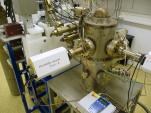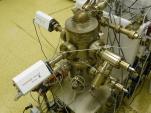 Name of Standard: National high vacuum standard
Name of Standard: National high vacuum standard
Code designation: EMC 170-714-054
Department: dpt. 6013 CMI RI Brno
Guarantor: Mgr. Martin Vičar, Ph.D.
Leakage Q (flow of very small currents into the vacuum) | Range: (1.10-8 až 8.10-2) Pa/m3s Uncertainty: 2.10-10 Pa/m3s + 0,012.Q |
Absolute pressure p | Range: (1.10-6 až 1.10-1) Pa Uncertainty: 5.10-8 Pa + 0,013.p |
In the field of high vacuum, only dynamic expansion systems can be used in practice. In this case, a well-defined gas stream enters the calibration chamber, which is pumped by a turbomolecular pump through an orifice whose conductivity is much greater than the pumping speed of the said pump. The pressure in the calibration chamber is then given by their ratio.
In the ranges from 1 Pa to 10-4 Pa of absolute pressure, the CMI had until recently to rely on the secondary standards based on the viscous vacuum gauge (SRG) principle regularly calibrated abroad, whose expanded uncertainty (k = 2, recognised in CMC) is U = 1∙10-5 Pa + 1,5∙10-2∙p. However, this situation is not satisfactory from the point of view of the primary laboratory in the long term.
Therefore, the CMI has developed its own primary standard - a dynamic expansion system - as part of the activities of the joint vacuum laboratory operated in cooperation with the Faculty of Mathematics and Physics at Charles University in Prague. In the case of this standard, the orifice has a diameter of approximately 11 mm. A constant pressure flow meter was chosen to generate an accurate value of the input flow rate. The range of flow rates required to cover the entire planned pressure range had to be realized by two flow meters. With their help, this apparatus can generate pressure values in the range of 0,1 Pa to 1∙10-5 Pa. Its uncertainties range from 1% to 1.8%. At present, the international comparisons have still not been concluded to confirm them. The effects of orifice geometry uncertainty, calibration gas impurities and pump speed instability on the overall uncertainty are much lower than the effect of flowmeter uncertainty. In contrast, the overall uncertainty of the standard is significantly affected by the instability and non-uniformity of the temperature distribution in the apparatus over the entire range of pressures generated, gas desorption and insufficient pump residual pressure at low pressures. These last two problems prevent the achievement of pressures lower than 1∙10-5 Pa.
At the same time, thanks to its primary flow meters, this apparatus serves as a primary standard for helium vacuum leaks in the range of (1∙10-1 to 1∙10-7) Pa∙m3∙s-1.



